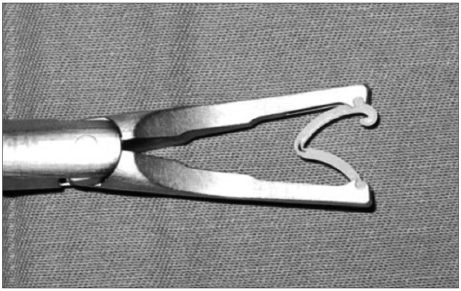Korean J Urol.
2007 Feb;48(2):120-124. 10.4111/kju.2007.48.2.120.
Comparison of Endo-GIA Stapler and Hem-o-lok Clip for the Vascular Control during Laparoscopic Nephrectomy
- Affiliations
-
- 1Department of Urology, College of Medicine, Kyungpook National University, Daegu, Korea. tgkwon@knu.ac.kr
- KMID: 2139748
- DOI: http://doi.org/10.4111/kju.2007.48.2.120
Abstract
-
PURPOSE: Vascular control is an important step during a laparoscopic nephrectomy. The application of an endovascular gastrointestinal anastomosis (endo-GIA) stapler has become a standard method for control of the renal vein during a laparoscopic nephrectomy. However, the device is expensive, and malfunctions resulting in significant complications have been reported. Recently, another stapling device (Hem-o-lok clip) has been developed and used for the management of the renal hilum during a laparoscopic nephrectomy. Herein, the uses of an endo-GIA stapler and Hem-o-lok clip were compared.
MATERIALS AND METHODS
Between August 2002 and April 2006, 288 laparoscopic nephrectomies (68 simple, 115 radical, 70 live donor nephrectomies, 35 nephroureterectomies) were performed via transperitoneal (n= 211), retroperitoneal (n=11) or hand-assisted (n=66) approaches. All patients were evaluated by detailed history taking, physical examination and laboratory investigations. Renal vein control was achieved solely using either an endo-GIA stapler (n=146) or Hem-o-lok clip (n=142), and renal artery control was obtained using Hem-o-lok clips alone or in combination with metal clips. The technical difficulty in obtaining vascular control, and the safety, cost, transfusion requirement and clinical outcomes were evaluated.
RESULTS
There were no statistically differences in the mean operation times and hospitalization stays between the two groups. No perioperative or postoperative complications occurred in the Hem-o-lok group. In contrast, two cases of inferior vena caval injury requiring open conversion, and one of postoperative rebleeding resulting in a reoperation, occurred in the endo-GIA group. Postoperative transfusions were required 17 and 7 cases in the endo-GIA and Hem-o-lok groups, respectively. CONCLISIONS: The Hem-o-lok technique is easy, safe and cost-effective compared to the endo-GIA stapler for vascular control during a laparoscopic nephrectomy.
Keyword
MeSH Terms
Figure
Reference
-
1. Clayman RV, Kavoussi LR, Soper NJ, Dierks SM, Meretyk S, Darcy MD, et al. Laparoscopic nephrectomy: initial case report. J Urol. 1991. 146:278–282.2. Wille AH, Roigas J, Deger S, Tullman M, Turk I, Loening SA. Laparoscopic radical nephrectomy: techniques, results and oncological outcome in 125 consecutive cases. Eur Urol. 2004. 45:483–488.3. Schweitzer EJ, Wilson J, Jacobs S, Machan CH, Philosophe B, Farney A, et al. Increased rates of donation with laparoscopic donor nephrectomy. Ann Surg. 2000. 232:392–400.4. Kim HH. Laparoscopic surgery in urology (I). Korean J Urol. 2003. 44:945–958.5. Guillonneau B, Abbou CC, Doublet JD, Gaston R, Janetschek G, Mandressi A, et al. Proposal for a "European Scoring System for Laparoscopic Operations in Urology". Eur Urol. 2001. 40:2–6.6. Kan SI, Seo IY, Jeoun HJ. Comparison of hand-assisted versus transperitoneal laparoscopic simple nephrectomy. Korean J Urol. 2006. 47:64–69.7. Oh CK, Rha KH, Yang SC. A comparison of open, laparoscopic, and video-assisted minilaparotomy radical nephrectomy. Korean J Urol. 2005. 46:925–930.8. Chan DY, Su LM, Kavoussi LR. Rapid ligation of renal hilum during transperitoneal laparoscopic nephrectomy. Urology. 2001. 57:360–362.9. United States Federal Drug Administration manufacturer and user facility device experience database (MAUDE). Available at http://www.fda.gov/cdrh/maude.html.10. Chan D, Bishoff JT, Ratner L, Kavoussi LR, Jarrett TW. Endovascular gastrointestinal stapler device malfunction during laparoscopic nephrectomy: early recognition and management. J Urol. 2000. 164:319–321.11. Soulie M, Salomon L, Seguin P, Mervant C, Mouly P, Hoznek A, et al. Multi-institutional study of complications in 1085 laparoscopic urologic procedures. Urology. 2001. 58:899–903.12. Deng DY, Meng MV, Nguyen HT, Bellman GC, Stoller ML. Laparoscopic linear cutting stapler failure. Urology. 2002. 60:415–420.13. Meng MV, Freise CE, Kang SM, Duh QY, Stoller ML. Techniques to optimize vascular control during laparoscopic donor nephrectomy. Urology. 2003. 61:93–98.14. Chueh SC, Wang SM, Lai MK. Use of Hem-o-lok clips effectively lengthens renal vein during laparoscopic live donor nephrectomy. Transplant Proc. 2004. 36:2623–2624.15. Baumert H, Ballaro A, Arroyo C, Kaisary AV, Mulders PF, Knipscheer BC. The use of polymer (Hem-o-lok) clips for management of the renal hilum during laparoscopic nephrectomy. Eur Urol. 2006. 49:816–819.
- Full Text Links
- Actions
-
Cited
- CITED
-
- Close
- Share
- Similar articles
-
- A Feasible Technique for Transient Vascular Occlusion by Using a Vessel Loop and Hem-o-Lok Clips in Laparoscopic Partial Nephrectomy
- Migration of a Hem-o-Lok Clip to the Ureter Following Laparoscopic Partial Nephrectomy Presenting With Lower Urinary Tract Symptoms
- The usefulness and safety of Hem-o-lok clips for the closure of appendicular stump during laparoscopic appendectomy
- Intravesical Stone Formation around a Hem-O-Lok Clip after Laparoscopic Radical Prostatectomy
- Abdominal Pain Due to Hem-o-lok Clip Migration after Laparoscopic Cholecystectomy



